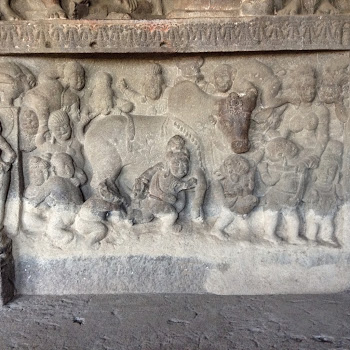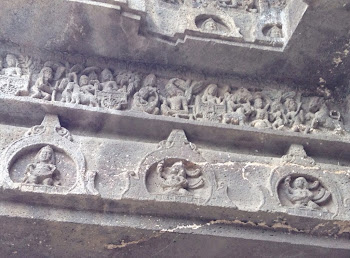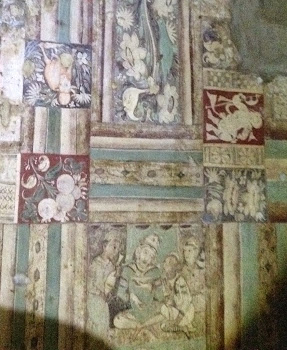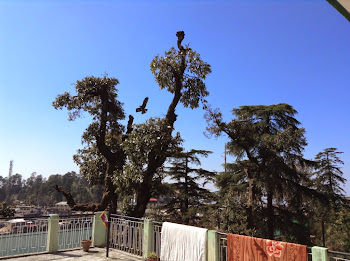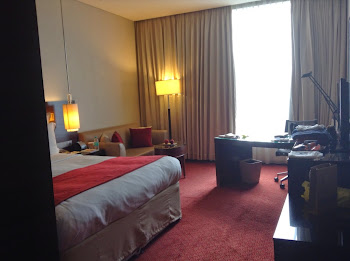Ellora is about 100 km from Ajanta. About the time the Ajanta caves fell into final disuse, the Ellora caves were being built. Between 500 and 900 AD first Buddhists, then Jains, then Hindus each developed numerous shrines and monasteries within walking distance of each other. This must have been a period of remarkable religious tolerance.
The Buddhist shrines, were the oldest and also the most serene. In cave 10 the acoustics were so fine that you could count about 7 reverberations of a single sound of Om. It was a beautiful and memorable moment.
More apsaras at the entrance.
Interesting columns (above) and stonework (below). Why the rock was carved as if with barrel staves, I don't know. Nor do I know if they affected the acoustics. What I do know for sure is that it was the most serene place I have been in all of India that I have seen.
And here is a closer view of Buddha with apsaras above his head? (I got pretty fond of Buddhist apsaras!)
The Jain caves were the next to be built. Much more embellished with symbols, but at the same time quite restrained and orderly, with a lot of balance around entrances and within each sculpture.
Not so the Hindu caves which is where the ancient stories were told within an abundance of rock carving. Here is a series just of hairdos of Shiva's wives(?) concubines (?) camp followers (?) - I will say that when sculptures have more than 2 arms, or are the Ganesh elephant, I can't quite cope! That's when suspending belief is beyond me. But the gods and goddesses are as alive in the culture now as they have ever been. Temples of every persuasion dot the Indian landscape like powdered sugar on a doughnut.
So these cave sculptures demonstrate the vibrancy of the Hindu culture. There's something in these stories for every occasion and for every desire. It is a rich response to life and living, and people stream to these caves every day, young and old, rich and poor. I can't help but wonder how similar it must have been in Egyptian, Greek and Roman times with all of their abundance of religious relevance. Instead of Ganesh it was Horus..... Instead of Shiva, Apollo or Juno. Etc.... In India, each of these religions still lives from very ancient time - and they are really and truly a life force in everyday life at every corner, wherever you happen to be in India. It is amazing and curiously captivating.
But before I go into further rhapsodies, I have to tell about the greatest of all rock cut caves - and of its type (a top down excavation) the biggest in the world - next in line being Christian rock cut churches in Ethiopia.
In the 200 years from beginning to completion, some vision had to be consistently maintained, which right there is a major accomplishment. I envision a family of project managers who passed their experiences down by word of mouth over the many generations. It also meant generations of rich Hindu believers who were willing to front the money even though they wouldn't see the final product. A lot of local politics lo those many years ago!
From the top of the "cave" where you can see grass to the very base is about 200 ft. a U-shaped trench was built while simultaneously the temple, and everything else, was carved from the top down. The top of each structure and pedestal is the most elaborate because the most money was available from rulers at the beginning of the project
Here is a favorite bas relief of a comedic story line - and lo and behold, there is the sacred cow, whose sacredness is VERY much in evidence all over India to this day! Just another fact of Indian life that makes no sense to my western mind
After finally carving down through 200 ft of basalt, the planners decided more depth was needed and at the back of the temple complex is a gigantic, unsupported cantilevered overhang of live rock with ceremonial cells carved even deeper into the mtn. It hasn't collapsed in more than 1000 years, but I was worried nonetheless.
The animals and multi armed gods depicted in the story of the Ramayana which is carved in some detail all over the walls of the temple. A big temple for a very big story.
And here are some of the people gathered on a work day at the temple. I was surprised by the number of Muslim families.
And the guide, Amod Basole, who kept us all fascinated for two quite spectacular days.
And quite out of order is the gorgeous apsara I found at the museum in Delhi, which I found just at closing time and didn't have a chance to jot down where it was from - as I wasn't supposed to be taking photos anyway.
Yes indeed, if given the chance I would return to Ajanta and Ellora in a flash.
Grabbing The Wave ... and hanging on for dear life
Every now and then there comes a moment when a vision MUST be made manifest. This is one of those times.
Tuesday, April 15, 2014
Ajanta - in search of apsaras
This weekend adventure meant quite a lot to me, perhaps most obviously because it joined my experience in China with the Ajanta caves. In particular I was looking for apsara representations because the ones in Dunhuang (~400AD) had so impressed me. Apsaras are Hindu and Buddhist supernatural women of clouds and water. These representations in Dunhuang were so stunningly beautiful, I wanted to see their evolution.
The Ajanta caves were dug out of a basaltic rock face layered with quartz striations which demarcated the layers of lava flow from so many millions of years ago - which formed the entire middle section of India and are known as the Deccan Traps. Into this ancient cliff side, Buddhist schools, shrines and monasteries were built - in two phases. 200-100 BC were the first 10. Then the place became overgrown during a Hindu majority. In ~450 AD a wealthy Buddhist benefactor encouraged the rest to be built and when he died some years later, the caves again became overgrown and the lair for tigers and other animal life. In 1819 a British hunting party "discovered" them again.
The caves were dug in from ceiling down with many of the interior spaces in the range of 4000 Sq ft. All the pillars, stupas and later statues were carved in place, top down from live rock. Nothing was carved and then moved. In itself that was a stunning feat - but the walls and several ceilings are frescoes and painted with wonderful depictions of Buddha's life. At Dunhuang the caves were carved from conglomerate rock and the walls frescoed also. But in that case all the statuary were modeled and burnished at the site. Nothing there was "live rock".
This ceiling was in its raw state and it's easy to see the lava flow here. It is thought that the existing layer had a puddle in it and when the new lava came quickly across it, the steam couldn't escape and so a large air pocket was formed. The area of this cave was about 4000sq ft and this flow was apparent throughout. It certainly made life easier for the diggers!
The original cuts were pure rock removal, but as the final surface was decided more rock smoothing was required. This shows an area where three different degrees of finishing show in one area. I was constantly confronted with the thought of stone tools to carve caves out of basalt with different degrees of finishing and talent. It was an amazingly difficult life, impossible for me to fully grasp.
Here is the hexagonal pillar, very finely finished to support the frescos - the cross beam, which was only stylistic as it was only live rock as were the ceiling and pillars - was slightly less finished, and the ceiling was as above - in it's very raw state. Other ceilings were fully carved and frescoed. Remember these frescos are at least 1500 years old!
And here, I was delighted to find, is an apsara!! As this cave was dug only a while before those in Dunhuang, the flying apsara - with ribbons - was a known image. Others were carved into the portico.
These are other ceiling frescos. And for me the most amazing wall fresco featuring a Celtic plaid! Did the Celts reach central India too??
Most of the painted walls told vivid stories of the life of Buddha, from his early years as a wealthy prince to his later years as an ascetic seeking enlightenment. By the way, he first started his path to enlightenment by sitting under a bodi tree to meditate. Here is a leaf from a bodi tree.
The later shrines and monasteries were elegant in their intricate design. Here are a few interior photos. Remember these are all still carved from live rock. Nothing was moved into a space, rather rock was removed to create a space.
Buddha, being tempted by the forces of good and evil, touches the ground with his hand to become "grounded" in truth.
If walking is too arduous, there is always the 4 man palaquin!
The Ajanta caves were dug out of a basaltic rock face layered with quartz striations which demarcated the layers of lava flow from so many millions of years ago - which formed the entire middle section of India and are known as the Deccan Traps. Into this ancient cliff side, Buddhist schools, shrines and monasteries were built - in two phases. 200-100 BC were the first 10. Then the place became overgrown during a Hindu majority. In ~450 AD a wealthy Buddhist benefactor encouraged the rest to be built and when he died some years later, the caves again became overgrown and the lair for tigers and other animal life. In 1819 a British hunting party "discovered" them again.
The caves were dug in from ceiling down with many of the interior spaces in the range of 4000 Sq ft. All the pillars, stupas and later statues were carved in place, top down from live rock. Nothing was carved and then moved. In itself that was a stunning feat - but the walls and several ceilings are frescoes and painted with wonderful depictions of Buddha's life. At Dunhuang the caves were carved from conglomerate rock and the walls frescoed also. But in that case all the statuary were modeled and burnished at the site. Nothing there was "live rock".
This ceiling was in its raw state and it's easy to see the lava flow here. It is thought that the existing layer had a puddle in it and when the new lava came quickly across it, the steam couldn't escape and so a large air pocket was formed. The area of this cave was about 4000sq ft and this flow was apparent throughout. It certainly made life easier for the diggers!
The original cuts were pure rock removal, but as the final surface was decided more rock smoothing was required. This shows an area where three different degrees of finishing show in one area. I was constantly confronted with the thought of stone tools to carve caves out of basalt with different degrees of finishing and talent. It was an amazingly difficult life, impossible for me to fully grasp.
Here is the hexagonal pillar, very finely finished to support the frescos - the cross beam, which was only stylistic as it was only live rock as were the ceiling and pillars - was slightly less finished, and the ceiling was as above - in it's very raw state. Other ceilings were fully carved and frescoed. Remember these frescos are at least 1500 years old!
And here, I was delighted to find, is an apsara!! As this cave was dug only a while before those in Dunhuang, the flying apsara - with ribbons - was a known image. Others were carved into the portico.
These are other ceiling frescos. And for me the most amazing wall fresco featuring a Celtic plaid! Did the Celts reach central India too??
Most of the painted walls told vivid stories of the life of Buddha, from his early years as a wealthy prince to his later years as an ascetic seeking enlightenment. By the way, he first started his path to enlightenment by sitting under a bodi tree to meditate. Here is a leaf from a bodi tree.
The later shrines and monasteries were elegant in their intricate design. Here are a few interior photos. Remember these are all still carved from live rock. Nothing was moved into a space, rather rock was removed to create a space.
Buddha, being tempted by the forces of good and evil, touches the ground with his hand to become "grounded" in truth.
If walking is too arduous, there is always the 4 man palaquin!
Guarded by elephants! Awesome striations!
Followed by groups wanting joint photos! We were all cultural explorers and wanted a record of it. The iPad mini has been a wonderful tool for making connections. So many people have so rarely seen their own photo. I could take lots of photos and give instant show and tell. If people had email addresses, I've been able to send their photos to them. :-))
Trying out our mudra positions - pretty unsuccessfully! Mary, a classmate from Cornell, and Sophia from Australia, who we met on this leg of the journey. This was a fabulous day for walking, exploring and learning. I loved this place!and IN HEALTH !!
Thank you to the hawk who dive bombed me in the head twice on the morning I was trying to decide about leaving Dharamsalla. I left!!
Thank you to the Shah's who, though with some hesitation because of their busy schedules, encouraged my return to Pune, where they could help me get to a good doctor and get good care.
Thank you to the really fine doctor who prescribed the 2 dose Secnil for the parasites and it worked like a dream.
Thank you to the lab which, though they promised to look hard, found no sign of parasites - twice.
THANK YOU TO THE J.W.MARRIOTT in Pune for having reasonable rates for a recovery period.
Who have without a doubt the most comfortable bed I've slept in since leaving home, with the most delicious scrunchy pillows. Who gave me a room above the noise and smells of a city.
Whose senior massage therapist helped me get grounded again.
Whose amazing staff of chefs provided every kind of delicious and tempting food, once I was ready to eat it. And who gave me two private cooking lessons, which I understand is very rare.
Whose well equipped gym allowed me to regain strength - more every day.
Whose accommodating and VERY friendly enormous staff of service people were with me every step of the way - from the lady who had to scan my purse every time I went in or out, to the concierge who helped me figure out how to unfreeze my computer, to the genial hostesses who introduced me to other single travelers looking for friendly conversation (though I was doing quite well on my own in that department!),
to the entire wait staff and many of the chefs who came to talk to me at each meal.
To the dazzling energy of one of the bartenders who took me under his wing and showed me an evening out in the "real Pune". And the other, whose story was ambitious and inspiring to me.
And the remarkable housekeeper who wished she had more time to make the jewelry she likes to make from trash she collects here and there.
Thanks to the flexibility of my schedule that I have had time to gradually recover from travel fatigue as well as dysentery. And thanks to my iPad mini which held tightly to all my memories, when I no longer could.
Thanks to my friend Rupali, who is arriving next week to travel with me and her family to Kashmir as a special treat during my last week in India.
I never got to volunteer here in India for one reason or another, but I have tried in each place I've been to leave behind warmth and goodwill. I certainly have had a rich and abundant time. There was so much traveling and so much minute by minute input that my mind couldn't absorb it all. I took photos, but I couldn't write.... This week I hope I can pull together my thoughts of the various angles on this trip. I hope I can adequately explain the cacophony of sound, sight, smell, taste, feeling, sensing and learning which was implicit in every step of the way. I'm ready to leave, but I wouldn't be sorry to return!
I leave here knowing that my privileged rest and recovery here has been major in preparing me for what may be my next enormous adventure. Only two days ago I was asked to join the administrative team at the school in Beijing where I worked last fall. I am seriously considering it, in part because I have regained my health and my strength. Two weeks ago I wouldn't have thought twice about saying no!
Thank you to the Shah's who, though with some hesitation because of their busy schedules, encouraged my return to Pune, where they could help me get to a good doctor and get good care.
Thank you to the really fine doctor who prescribed the 2 dose Secnil for the parasites and it worked like a dream.
Thank you to the lab which, though they promised to look hard, found no sign of parasites - twice.
THANK YOU TO THE J.W.MARRIOTT in Pune for having reasonable rates for a recovery period.
Who have without a doubt the most comfortable bed I've slept in since leaving home, with the most delicious scrunchy pillows. Who gave me a room above the noise and smells of a city.
Whose senior massage therapist helped me get grounded again.
Whose amazing staff of chefs provided every kind of delicious and tempting food, once I was ready to eat it. And who gave me two private cooking lessons, which I understand is very rare.
Whose well equipped gym allowed me to regain strength - more every day.
Whose accommodating and VERY friendly enormous staff of service people were with me every step of the way - from the lady who had to scan my purse every time I went in or out, to the concierge who helped me figure out how to unfreeze my computer, to the genial hostesses who introduced me to other single travelers looking for friendly conversation (though I was doing quite well on my own in that department!),
to the entire wait staff and many of the chefs who came to talk to me at each meal.
To the dazzling energy of one of the bartenders who took me under his wing and showed me an evening out in the "real Pune". And the other, whose story was ambitious and inspiring to me.
And the remarkable housekeeper who wished she had more time to make the jewelry she likes to make from trash she collects here and there.
Thanks to the flexibility of my schedule that I have had time to gradually recover from travel fatigue as well as dysentery. And thanks to my iPad mini which held tightly to all my memories, when I no longer could.
Thanks to my friend Rupali, who is arriving next week to travel with me and her family to Kashmir as a special treat during my last week in India.
I never got to volunteer here in India for one reason or another, but I have tried in each place I've been to leave behind warmth and goodwill. I certainly have had a rich and abundant time. There was so much traveling and so much minute by minute input that my mind couldn't absorb it all. I took photos, but I couldn't write.... This week I hope I can pull together my thoughts of the various angles on this trip. I hope I can adequately explain the cacophony of sound, sight, smell, taste, feeling, sensing and learning which was implicit in every step of the way. I'm ready to leave, but I wouldn't be sorry to return!
I leave here knowing that my privileged rest and recovery here has been major in preparing me for what may be my next enormous adventure. Only two days ago I was asked to join the administrative team at the school in Beijing where I worked last fall. I am seriously considering it, in part because I have regained my health and my strength. Two weeks ago I wouldn't have thought twice about saying no!
Subscribe to:
Posts (Atom)














